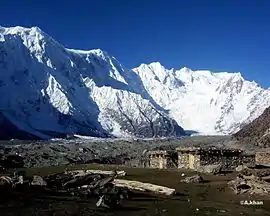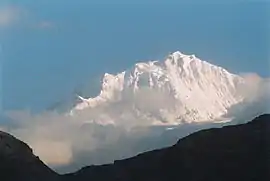Highest unclimbed mountain
An unclimbed mountain is a mountain peak that has yet to be climbed to the top. Determining which unclimbed peak is highest is often a matter of controversy. In some parts of the world, surveying and mapping are still unreliable. There are no comprehensive records of the routes of explorers, mountaineers, and local inhabitants. In some cases, even modern ascents by larger parties have been poorly documented and, with no universally recognized listing, the best that can be achieved in determining the world's highest unclimbed peaks is somewhat speculative. Most sources indicate that Gangkhar Puensum (7,570 metres (24,840 ft)) in Bhutan or on the Bhutan–China border is the tallest mountain in the world that has yet to be fully summited. Gangkhar Puensum has been off limits to climbers since 1994 when Bhutan prohibited all mountaineering above 6,000 m (20,000 ft) due to spiritual/religious beliefs.[1]

Unclimbed mountains are sometimes referred to as "virgin peaks." Many virgin peaks exist because the mountain is unreachable, due to either geographic isolation or political instability. Some mountains remain off limits due to religious beliefs of a country or region that hold such mountains as sacred and should remain inviolate. Additionally, since the endeavor to scale taller mountains of the world is usually a major undertaking, lesser peaks, while still very formidable, simply get less attention than the taller ones, and instead these taller peaks are summited by parties following a new route or perhaps during the winter when conditions are generally more treacherous.[1]
Challenges in definition
Definition of a mountain

Many mountains, in addition to their highest point or peak, will also have subsidiary subpeaks. Generally, the topographic prominence of a peak or subpeak, as well as the general topography, all come into consideration when determining whether such apexes are considered to be independent peaks or subpeaks. Although objective criteria have been proposed for distinguishing peaks from subpeaks, there is no widely agreed standard. In 1994, the International Climbing and Mountaineering Federation (UIAA) classified 82 mountain peaks in the Alps whose summits were at least 4,000 m (13,000 ft) above sea level and with at least 30 m (98 ft) of topographic prominence over any adjacent mountain pass or col, as a distinct peak.[2]
Verification of unclimbed status
It can be difficult sometimes to determine whether or not a mountain peak has been fully summited. Long before modern mountaineering commenced in the middle of the 19th century, evidence indicates that people did indeed travel up to the summits or near to the summits of major mountain peaks. Archaeological excavations in the Andes have shown that humans travelled up to 6,739 m (22,110 ft) in pre-historic times.[3] Permanent settlements as high as 4,500 m (14,800 ft) were established as far back as 12,000 years ago in the Andes.[4] In the Greater Himalaya region, Lhasa, in Tibet, sitting at 3,650 m (11,980 ft) has been permanently occupied since the 7th century and many smaller settlements across the Greater Himalaya thrive at elevations exceeding 4,000 m (13,000 ft).[5] With humans living at high elevations for many millennia, nearby peaks to such settlements may or may not have been summited at some point in the past. However, many regions away from settlements may never have been explored, especially since some high peaks in the Greater Ranges are so remote that they were unknown to local inhabitants until they were sighted by explorers.
The world's third tallest peak, Kangchenjunga, has been summited a number of times, but after the first climbers of the peak agreed to honor the wishes of locals and not set foot on the topmost part of the mountain, succeeding mountaineering parties may have followed this tradition. Similarly, Nanda Devi has also been climbed but the topmost summit was not ascended and the primary summit is now off limits to climbers. Machapuchare had only one summit attempt back in 1957 when climbers came within 150 m (490 ft) of the summit; Nepal then banned future attempts.[6]
Gangkhar Puensum

The mountain most widely claimed to be the highest unclimbed mountain in the world in terms of elevation is Gangkhar Puensum (7,570 m (24,840 ft)).[7] It is in Bhutan, on or near the border with China. In Bhutan, the climbing of mountains higher than 6,000 m (20,000 ft) has been prohibited since 1994.[8] The rationale for this prohibition is based on local customs that consider this and similar peaks to be the sacred homes of protective deities and spirits,[9] and the lack of high-altitude rescue resources from any locale closer than India. The prohibition was further expanded in 2003 when mountaineering of any kind was disallowed entirely within Bhutan.[10] Gangkhar Puensum will likely remain unclimbed so long as the government of Bhutan prohibits it.[11]
Highest unclimbed non-prohibited peak

It is unclear which is the highest unclimbed non-prohibited mountain. While some recognize only peaks with 100 m (330 ft) of topographical prominence as individual summits, the International Climbing and Mountaineering Federation uses a 30 m (98 ft) cutoff for determining individual summits. Based on the International Climbing and Mountaineering Federation's criteria, Muchu Chhish (7,452 m (24,449 ft) with a prominence of 263 m (863 ft)) in Pakistan is currently the world's tallest that has not been climbed even though it is legal to do so. Other unclimbed summits include one on the massif known as Kabru (7,318 m (24,009 ft) prominence c. 100 m (330 ft)), Labuche Kang III/East (7,250 m (23,790 ft)) with prominence of 570 m (1,870 ft) and Karjiang (7,221 m (23,691 ft) with a prominence of 895 m (2,936 ft)).[12]
Most prominent unclimbed peak
Unclimbed candidates with high topographic prominence are by definition independent mountains, but some have relatively modest elevations. With such peaks there is a greater possibility of undocumented ascents, perhaps occurring long ago.
As of mid-2014 Sauyr Zhotasy (3,840 m (12,600 ft), prominence of 3,252 m (10,669 ft)), the highpoint in the Saur Range on the border between Kazakhstan and China, and Mount Siple (3,110 m (10,200 ft), prominence of 3,110 m (10,200 ft)) on Siple Island off the coast of Antarctica, have no record of successful ascents.[12] The unclimbed status of each of these peaks is difficult to confirm, although Mount Siple in particular is remote, uninhabited (and without any nearby habitation), and seldom visited. The most recent remaining most prominent mountain summited (with a prominence of 12,169 ft (3,709 m)) was in June of 2014 in the Finisterre Range of Papua New Guinea.
List of highest unclimbed peaks
The following peaks, with a minimum prominence of 150 m (490 ft), were thought to be unclimbed as of August 2018.[13]
Mountains with prominence over 300m in bold.
| Rank | Peak | Height | Prominence | Parent | Location | ||
|---|---|---|---|---|---|---|---|
| m | ft | m | ft | ||||
| 1 | Gangkhar Puensum | 7570 | 24836 | 2995 | 9826 | Kangchenjunga | Bhutan/Tibet |
| 2 | Muchu Chhish | 7453 | 24452 | 263 | 863 | Batura Sar | Pakistan |
| 3 | Kunyang Chhish West | 7350 | 24114 | 202 | 663 | Kunyang Chhish | Pakistan |
| 4 | Summa Ri I | 7302 | 23957 | 246 | 807 | Skilbrum | Pakistan |
| 5 | Lapche Kang III | 7250 | 23786 | 570 | 1870 | Lapche Kang | Tibet |
| 6 | Apsarasas Kangri [14] | 7243 | 23763 | 607 | 1991 | Teram Kangri I | India |
| 7 | Karjiang I | 7221 | 23691 | 895 | 2936 | Kula Kangri | Tibet |
| 8 | Tongshanjiabu | 7207 | 23645 | 1757 | 5764 | Gangkhar Puensum | Bhutan/Tibet |
| 9 | Skyang Kangri West | 7174 | 23537 | 194 | 636 | Skyang Kangri | Pakistan |
| 10 | Yermanendu Kangri | 7163 | 23501 | 163 | 535 | Masherbrum | Pakistan |
| 11 | Chamar South | 7161 | 23494 | 219 | 719 | Chamar | Nepal |
| 12 | Namcha Barwa II | 7146 | 23445 | 166 | 545 | Namcha Barwa | Tibet |
| 13 | Chongtar Kangri NE | 7145 | 23442 | 205 | 673 | Chongtar Kangri | Xinjiang |
| 14 | Asapurna I | 7140 | 23425 | 262 | 860 | Annapurna I | Nepal |
| 15 | Urdok Kangri II | 7137 | 23415 | 321 | 1053 | Sia Kangri | Pakistan/Xinjiang |
| 16 | Praqpa Kangri I | 7134 | 23406 | 668 | 2192 | Skilbrum | Pakistan |
| 17 | Mandu Kangri ?[15] | 7127 | 23383 | 630 | 2067 | Masherbrum | Pakistan |
| 18 | Annapurna Dakshin NE | 7126 | 23379 | 151 | 495 | Annapurna Dakshin | Nepal |
| 19 | Teri Kang | 7125 | 23376 | 454 | 1490 | Tongshanjiabu | Bhutan/Tibet |
| 20 | Sanglung | 7095 | 23278 | 995 | 3264 | Namcha Barwa | Tibet |
See also
- List of peaks by prominence
- List of highest mountains
References
- Nuwer, Rachel (4 July 2014). "The mountains we have never climbed". BBC. Retrieved 14 February 2018.
- "Mountain Classification". UIAA-International Climbing and Mountaineering Federation. Retrieved 14 February 2018.
- Reinhard, Johan; Ceruti, Constanza (2010). Inca Rituals and Sacred Mountains: A Study of the World's Highest Archaeological Sites. Institute of Archaeology Press. ISBN 9781931745765.
- Ghose, Tia (23 October 2014). "Oldest High-Altitude Human Settlement Discovered in Andes". Live Science. Retrieved 14 March 2018.
- Gill, Nicholas (8 February 2016). "Where are the world's highest cities?". The Guardian. Retrieved 14 March 2018.
- "The Four Forbidden Mountains in the Himalayas". Climb Report. 6 March 2016. Retrieved 16 March 2018.
- Tsuguyasu Itami (October 2001). "Gankarpunzum & First Ascent Of Liankang Kangri" (PDF). Japanese Alpine News. 1. Retrieved 14 March 2018.
- Verschuuren, Bas (2016). "Nye within protected areas of Bhutan". Asian Sacred Natural Sites: Philosophy and practice in protected areas and conservation. Routledge.
- Verschuuren, Bas (2016). "Nye within protected areas of Bhutan". Asian Sacred Natural Sites: Philosophy and practice in protected areas and conservation. Routledge.
- Mason, Colin (2014). "Nepal and Bhutan". A Short History of Asia. Macmillan International Higher Education. ISBN 9781137340634.
- Jennings, Ken (14 December 2015). "What's The World's Highest Mountain That's Never Been Climbed". Conde Nast. Retrieved 14 March 2018.
- Newcomb, Tim (19 January 2018). "7 of the Tallest Unclimbed Mountains in the World". Popular Mechanics. Retrieved 14 March 2018.
- Eberhald Jurgalski, High Asia – All mountains and main peaks above 6750 m, 17 August 2018 release
- Jurgalski considers the unclimbed peak known as "Apsarasis III" just higher than "Apsarasis I" (7241 m), which was climbed in 1976.
- While Jurgalski listed this peak, also known as Masherbrum Far West, as unclimbed in August 2018, there is a report of a first ascent in September 1988